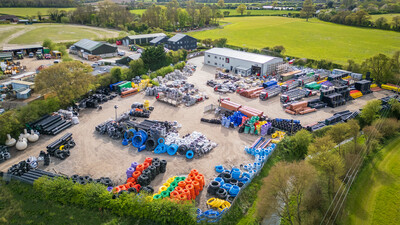Let’s take a closer look at the differences between the two systems and the reasons for these differences.
Soil vs. Waste: What’s The Difference?
You might argue that all this is wastewater, but that isn’t strictly true. If it comes from a toilet, it should be referred to as soil (or blackwater). By the way, a bidet should also be connected to the soil system.
Wastewater (also known as greywater) covers pretty much anything else – sinks, washing machines, dishwashers, basins, baths and showers.
Waste pipes vary in diameter: 32mm is used for small hand basins and 40mm for showers and baths, kitchen sinks, washing machines and dishwashers. Multiple waste pipe connections and commercial use often require 50mm diameter pipe.
Soil pipes require a larger diameter due to the solids they handle. For aboveground pipework, it’s common to use 110mm diameter pipe, with 160mm diameter pipe used underground, particularly if the system serves several houses or a large building with many toilets.
What Are Soil & Waste Pipes Made From?
You may find cast iron soil pipes on older properties. However, these are prone to corrosion and can even crack due to ground or structural movement.
Modern soil pipes are made from plastic, which has several benefits.
- They weigh less than cast iron and are faster to cut, so they are easier to carry and install
- They are more flexible, which also makes them easier to install while being more resistant to movement
- They don’t rust and are more resistant to chemicals, making them more durable
- They are manufactured in longer lengths, so fewer joints are required during installation
- They contain no asbestos, unlike some cast iron pipes
Waste pipes made from copper, iron or lead may still be found in older properties. Modern waste pipes are generally made from plastic, although copper pipe is still used in some situations. For example, its resistance to temperatures of up to 200 degrees Celsius may be required in commercial and industrial applications or the aesthetic appeal of polished copper may be preferred for exposed pipework.
What Are Soil Stacks & Waste Stacks?
Soil stacks and waster stacks serve a similar purpose: they are vertical pipes running down through the property with smaller-diameter pipes forming branches. The branches of a soil stack connect to toilets, urinals and bidets, while those of a waste stack connect to baths, sinks, washing machines and so on.
Some properties feature a single stack for soil and waste, while other properties have separate soil and waste stacks.
What Are Soil Vent Pipes & Air Admittance Valves?
Water containing biological waste produces unpleasant odours and dangerous gases such as methane (this is why food scraps shouldn’t be flushed down the kitchen sink). To allow these odours and gasses to escape into the outside air, a soil pipe system is connected to a vent pipe.
This also runs vertically up through the property and terminates above the roofline, where the odours and gasses can dissipate safely. To prevent odours from re-entering the property or adjacent buildings, the exit point must be at least 900mm higher than any window or other opening within a distance of 3 metres.
Air admittance valves act almost like vent pipes in reverse; they allow fresh air to enter a soil or waste system to help balance the system pressure. However, as they are a one-way valve, they don’t allow gasses to escape. The entry point of an air admittance valve must be at least 200mm above the system’s highest wet point (a place where water enters the system from a toilet, hand basin, etc.).
As waste pipes shouldn’t contain human biological waste they don’t require venting but should still be fitted with an air admittance valve to equalise the pressure in the system.
We hope you have found this information helpful and interesting. As always, we recommend seeking professional advice before embarking on any projects that you are unfamiliar with, and if you have any further questions you are always welcome to call our friendly team of experts on 01420 555600 or email [email protected].
Also, look out for more articles in our ongoing series of blog posts, bringing you useful information, insights, guides and tips on all things drainage!

Written by
Mark Chambers
Head of Marketing
As Head of Marketing, Mark plays an active role in running strategic projects to increase our brand profile.

